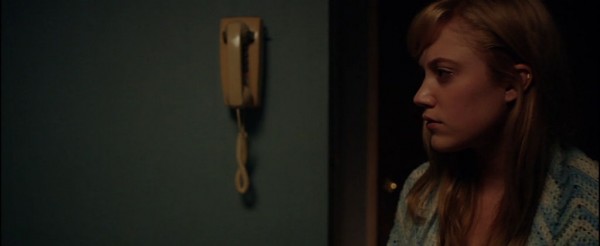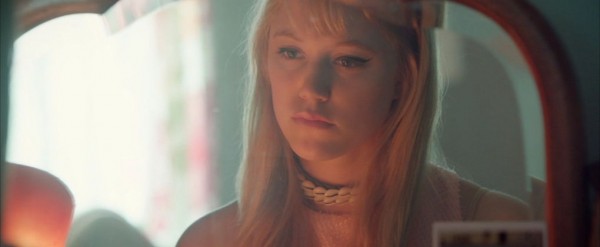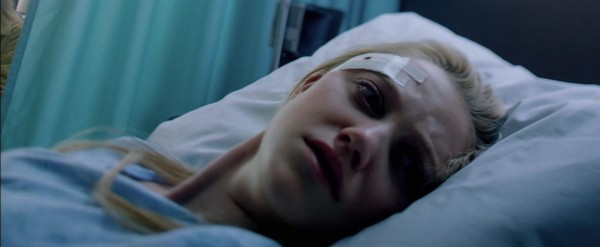
It Follows, part 3: The aesthetics of fright
The freeze frames from It Follows used in this article are taken from a screener made available to Montages by the film’s Norwegian distributor. The article reveals the whole plot.
*
This is the last of three analytical articles about It Follows by David Robert Mitchell. The first article is a general discussion on the film, structured around ten different approaches to this many-faceted work. The second article explores central motifs like sleep, water and red colour-coding.
This third article is about the film’s staging and aesthetics. It culminates in an exploration of the discreetly striking sequence where the protagonist wakes up in hospital to a reality turned strange: a tour-de-force of atmosphere, limited point-of-view and quiet paranoia. The article leans heavily on freeze frames from the film and takes for granted that the reader is already familiar with the plot.
Film analysis is a not always linear process, however. As a small prologue, here comes an item that springs from the first article’s thematic metaphors and the second article’s exploration of the colour red:
It is not coincidence that the Old Maid card game appears in It Follows. Like the fact that there is only one Follower, there is only one Old Maid card in the deck. Like the importance of passing the film’s curse on to another person, it is imperative to pass the Old Maid card on to another player. If this fails, one ultimately dies/loses the game. The card in the above image is also coloured red, which can be traced back to red being associated with the danger of the Follower. Finally, the Old Maid connotation functions as an ironic upside-down version of the curse, connected as it is to sexual promiscuity.
The careful Mitchell also takes the time to demonstrate the game’s circular nature:
Staging rich in ideas
David Robert Mitchell has said that It Follows intentionally blends props and elements from several time periods in an attempt to create a timeless tale. This conceit can also be interpreted as a signal about the film’s importance as metaphor, rather than a “reality-based” story. (The deliberate confusion of periods has actually been a stumbling block for viewers insisting on a literal approach to cinema.) This is the reason that the teenagers constantly watch 1950s movies, and when Greg (Daniel Zovatto) observes the commotion across the street after the protagonist Jay (Maika Monroe) has been assaulted, the sound of an old-fashioned newsreel or documentary can be heard in the background.
Furthermore, among other things we see TV technology from the 1970s and 80s, while Yara (Olivia Luccardi) uses an e-book reader that in its futuristic design is beyond time. And could it be that Mitchell is also mixing up the seasons? The colour of vegetation places the film in the fall, but the characters are still quite lightly dressed without seeming to be cold, and on several occasions they are bathing and sunning themselves.
It Follows is a very good-looking film. Here are a few memorable compositions:


Now for some Follower situations. The old lady Jay discovers through the classroom window is accompanied by the teacher reading aloud the poem «The Love Song of J. Alfred Prufrock» by T. S. Eliot. One of its lines, «I am Lazarus, come from the dead», perfectly suits the proceedings, and is quoted just before the Follower is seen (the entire poem is here).


Paul (Keir Gilchrist) ponders at one point passing the curse on to some prostitutes. In the below image, the constellation of windshield and rear mirror constitutes a clever summary of a central point of the film: The windshield with the prostitutes represents the future and a potential solution to the Follower problem. The rear mirror symbolises the past, where a Follower can turn up at any time, as a result of the past actions of the character. The shot is clearly composed to give the rear mirror an active role:


The following slide show presents the stages of one of the most virtuosic scenes in It Follows. The teenagers visit a school to find out the real identity of Jay’s boyfriend – through a 91-second take where the camera swivels around its own axis twice, before it ends in a stylised climax closing in on a situation framed by a doorway. (In the second article we saw how the shot both started and ended with the colour red.) In this scene Mitchell seems determined to only show the faces of the main characters and the Follower. Virtually everyone else is seen from behind – in line with the film’s general strategy of hiding other people’s faces – we only see a little of the face of the blond girl in image no. 3.
The movements of the various figures are precisely coordinated to suit the camera’s circular motion. This continues during the concluding tracking shot, where Jay and Greg are just in time to pass in front of the camera after finishing the conversation with the lady in red. Furthermore, for every revolution of the camera circle we see the potential Follower in a more advanced position. Here my thoughts go to the famous tennis scene in Hitchcock’s Strangers on a Train (1951), where among the match spectators, the only one facing the camera is the protagonist’s nemesis (played by Robert Walker – an amusing name when associated with the Follower).
The freeze frame with red borders is the first one of the slide show. (At any time the show can be restarted from the beginning: click on the current image and after its enlargement, return to the article.)

Now we arrive at the sequence culminating in the Follower’s appearance in the kitchen. There are lots of interesting things about the build-up, not least how the old science fiction movie on the TV is commenting on the action. (In both previous articles – for example in item 6 of the first one – we have already seen how its dialogue is doing so.)








The following situation was already studied in the first article (item 8), so it is here presented only through a slide show. Unlike many of the Follower incidents, this situation is made very strange through the use of ultra-slow motion. Jay also moves in an artificial, “geometric” fashion, in 90 degree turns. As she arrives at the phone, she stops, hiding it with her head. The phone here seems to symbolise some sort of communication with the supernatural, because it is exactly at this point she turns, and then spots perhaps the most terrifying Follower of them all: an abused woman in a state of constant urination (the water motif again).




Dominant camera movements
Camera movement is exceptionally important to It Follows. In the first article we have already discussed two prominent stylistic figures, respectively a frequent forward motion (item 5) and filming transport-by-foot scenes in a pattern rhythmically alternating between shooting the characters from behind and facing the camera (item 10). Here we shall look at a few other types of cases, which often contribute decisively to the lyrical intermessos that is so important to the film’s peculiar atmosphere.

Later, Jay is doing her make-up before her date. The below slide show is compressing a 69-second take where the camera is closing in on her in a slow curve, before it ends up in a fetishising, lingering close-up of her mirror image. The movement suggests that the mirror image, her appearance, is more important to her than herself. The mood is highly ambiguous: Jay’s innocence is emphasised – even exaggerated, since she is made up and lighted so she looks much younger than her 19 years – but her final gaze into the mirror seems fatalistic, almost resigned. Most of all she looks like a melancholy princess:

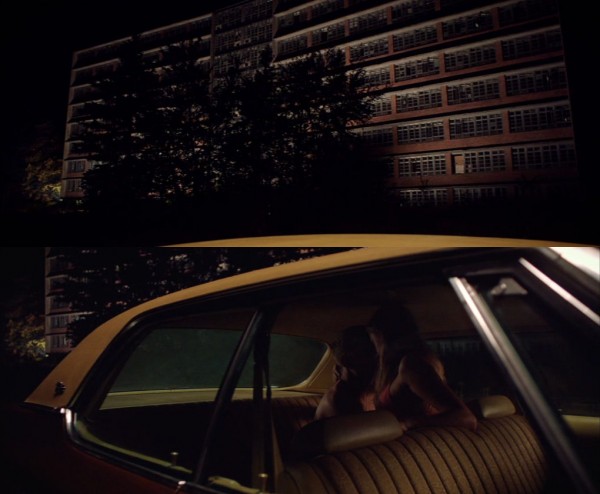

The first article (item 5) compared Mitchell to M. Night Shyamalan due to his methodical approach to form and pacing. Towards the end of It Follows Mitchell launches a very Shyamalanian manoeuvre: a “geometric” movement where the camera moves laterally in a straight line, back and forth between the characters. (This was often used in Unbreakable (2000); the form of that film is analysed in this article, and the section on lateral movements is here). The melancholy scene takes place directly after Jay and Paul’s intercourse, offering up some of the film’s most beautiful close-ups.

The climax in the swimming hall
It Follows features a dramatic climax. The teenagers wait for the Follower in a swimming hall, where they manage to defeat it (but nobody seems sure that the victory was final). We shall start, however, with the scene where Paul gets the idea of luring the Follower to the hall. Paul yearns to protect Jay, and perhaps even more to sleep with her, but she deflects his attempt to kiss her:
Then he looks up at the mirror, where a photograph of Jay hangs, taken at the swimming hall. Since it was there he kissed her as a child – her first kiss – his awareness of that seems to give him the idea. If he can help her defeat the Follower, at the location of their first kiss even, he can win the girl he has dreamed of conquering since childhood. Below the photograph lurks the picture of her father, whose body the Follower will wear during the climax. On top of everything, Jay seems to have pouting lips in the photo, as if she is tempting Paul, promising him another kiss if he can beat the Follower.
Innocence, budding sexuality, desire driven by ambiguous and “confused” intentions, incestuous undercurrents, the film’s concrete plot, the kiss that Jay just denied him – it is fascinating to see how elements interact like clockwork in this short moment of the film.
The climax has been criticised from many quarters for not maintaining the same quality as the rest of the film, according to a more narrow genre-oriented evaluation. Some of the criticism claims that the proceedings suddenly depart from Jay’s point-of-view and that we see too little of the Follower. It is correct that part of the scene is told from the other teenagers’ viewpoint, to whom the Follower is invisible – but for good reason, since this emphasises how difficult it is for the others to stop a threat they cannot see. But the scene also contains several situations seen from Jay’s point-of-view, down in the pool, with the Follower as a highly concrete threat – driven home by the below image:
If the climax deserves criticism, it is that the scene entails an abrupt change of tone. In addition to the engaging performances, the film’s sobriety has lent great verisimilitude to the peculiar premise. The climax belongs to another playbook entirely, and is like a hectic, highly dramatic circus number. A few questions are also surfacing: Since Paul turns out to have superhuman shooting abilities, should he not, at least, be shown to take part in the gun practice at Greg’s cabin? Paul’s plan is inspired by Jay’s photo, but should we not have been given more insight into his thought process – why does precisely this method point itself out to destroy the Follower?
The teenagers intend to lure the Follower into the pool, and then throw electrical appliances into the water to kill it by electric shock. The Follower seems to see through their plan, however, and refuses to enter the water. Instead it is throwing the appliances at Jay. Is this to kill or just drive her out of the pool? If the goal is to kill, why does the Follower not use the same method as the teenagers have planned? Why does not Jay herself die from shock when the first appliance comes flying? Is it not enough with one appliance? The youths themselves are confused about this, and the script could have spent a bit of explanatory dialogue just here. What actually happens is the following:

So the Follower is throwing the appliance so far that the contact is torn out of the socket. Is the temporary black-out of the hall an indication that something has gone wrong with the hall’s entire electric supply as a consequence of this? Why do we then also see a tongue of flame from the socket when the Follower is throwing the second appliance? Are there only two electric sockets in the hall, so that the appliances, who may all have been connected through multiple sockets (we actually see some of those before), are disconnected? Maybe we shall have to ask an electrician.
Some have also thought it odd that the Follower is shot in the head before it falls into the water, but it revives. Why does it then succumb after another head shot? Since this is a supernatural being, it leads really nowhere to speculate about this: the conclusion is probably that it is especially vulnerable when in water.
It feels slightly distasteful to descend into this kind of nit-picking in a film clearly intended as a metaphor. Nevertheless, Mitchell might have been a bit clumsy here. The climax has created false notes for some viewers at their first encounter with the film, while others have taken everything in their stride. To my eyes, the problems, if any, are confined to a short period – merely at the start of the climax – and in later viewings, the “circus number” has turned into one of the film’s highlights.
The climax is part of a longer sequence. This chapter shall concentrate on the sequence’s considerable qualities in aesthetics and mood-creation:


Mitchell makes a very daring decision before the climax: he slows the pace of the action to almost zero, devoting more than three and a half minute for preparation and waiting for the Follower to turn up. During this period Jay’s little sister Kelly (Lili Sepe) plays an aesthetic part with a talent for elegant postures:




But again Paul succeeds in shooting the Follower. Time for yet another Shyamalanian lateral tracking shot, back and forth, where Jay first manages to get out of the water, but then has to follow the same route back to see what has happened to the Follower. (Since she is the only one who can see it.) The nightmare refuses to let up, and the repetitive camera journey underscores this, in this slide show:
The scene’s conclusion has already been described in the second article: Jay’s hands creeping closer to the edge of the pool, where the water is soon turned overwhelmingly red by the Follower’s blood.
Awakening to unreality
The scene where Jay awakens at the hospital after having driven off the road is a brilliant tour-de-force of atmosphere, limited point-of-view and quiet paranoia. (The scene lasts four minutes and ten seconds.) This walk-through will also point out the local use of a few motifs we have dealt with in the previous articles.




Now the reason for the shoes being red is revealed. It is a harbinger. So far in the scene, he silence has been resounding, but suddenly Jay hears ghostly sounds of footsteps in the distance:
While the sound increases in strength and everything else is total silence, a segment follows that is based on an extremely simple, yet terrifyingly effective and expressive formal construction. The following slide show dissects the segment shot by shot, movement by movement (the image with red borders marks the start of the show):
The steps turned out to come from a nurse, but David Robert Mitchell continues the construction a bit more, still supported by the camera’s quietly obsessive forward motion. As seen in countless examples in the three articles, this has to be the dominating stylistic figure in It Follows:
With purely cinematic devices and in a manner unique to film as an art form – highly concrete, yet inscrutable and metaphorical – Mitchell drives home, with elegance and striking simplicity, that Jay’s nightmare will never end. There will always be new sounds, new threatening spaces, new corners that the Follower at any time can come around. Jay cannot take it any more:


The camera now embarks upon a very art-film-like journey, through a long take of 63 seconds, that is reminiscent of the film’s large circular motions: in the opening scene and the situation at the school already described. Almost all the tableux that the camera will now reveal seem to comment on either the film generally or present small foreshadowings of the shot’s culmination. As usual, almost no adult’s face is shown without good reason. The red brick wall between each window functions as a sort of cut between each “scene”:







Afterwards comes one of the film’s most beautiful and ambiguous shots. It radiates relief and sexual satisfaction, but also suggests that she is some sort of “fallen woman”, since she has in practice prostituted herself to get rid of the curse:

Suddenly the mood changes abruptly, emphasised by an almost comical, jaunty film music. We are now part of Greg’s happy-go-lucky, capricious and womanising world. We have the feeling that Greg does not really believe in the curse, but anyway it suits him fine to sleep with someone. Like in the scenes where Jay swims out to the boys in the boat and Paul cruises after prostitutes, the film merely suggests the nature of Greg’s intentions. When he later visits Jay at the hospital, he is again “posing” as her boyfriend, says nothing about having had sex with someone, and maintains that he has not noticed any Follower. In reality he has only bought himself time – perhaps without really having found it necessary.

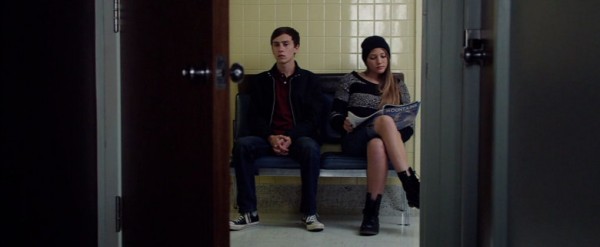
*
One can never be sure about how many of these analytical finds coincide with David Robert Mitchell‘s intention. They are, however, in line with the spirit of It Follows and its exploration of themes. These three articles hopefully succeed in demonstrating the richness of ideas one single film can contain.



















